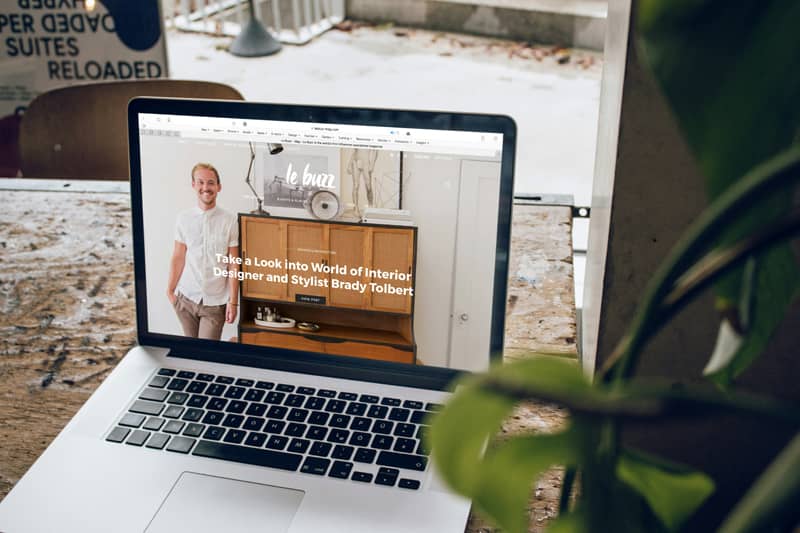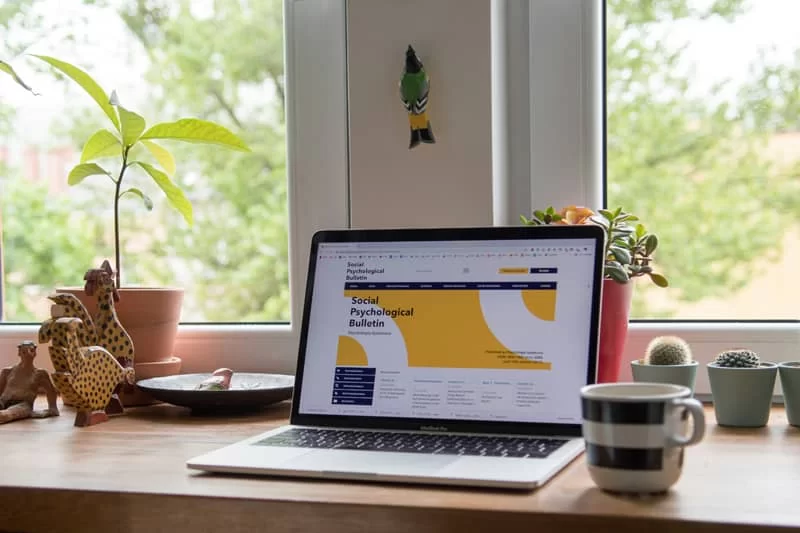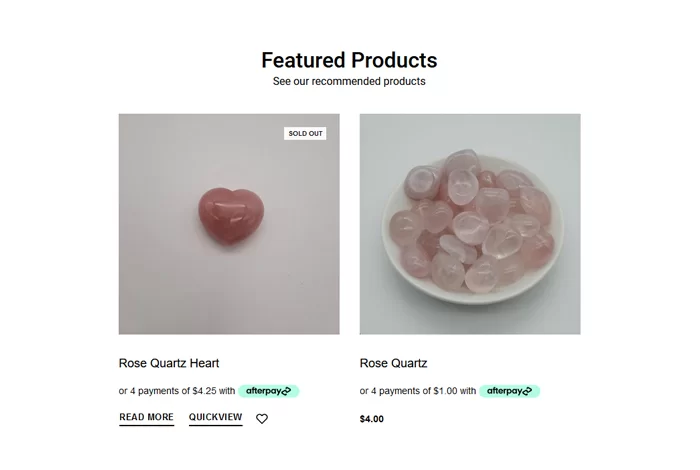Why Your Business Needs a Professionally Made Single Page Website

Why Choose A Professionally Made Single Page Website?
A single-page website is an ideal choice for small businesses looking to establish their online presence in a cost-effective and impactful way. Here are some of the top reasons why a single-page website may be the perfect fit for your business:
- Simplicity: With all of your content on one page, there’s no need for users to navigate through multiple pages to find what they’re looking for. This ensures a streamlined and straightforward user experience, making it easier for potential customers to engage with your business.
- Effective Communication: A single-page website forces you to be concise in your messaging, which can be extremely effective in communicating your business’s values and services clearly and persuasively. With limited space to work with, every word and image on your webpage needs to have a strong impact.
- Mobile-Friendly: In today’s digital age, it’s crucial for businesses to have a website that is optimized for mobile devices. With a single-page website, all of your content is condensed into one page, making it easier for users to navigate on their mobile devices.
In this article we will explore more reasons why a single page website can be a great investment for those seeking a simple online presence on the internet without breaking the bank.

Understanding the Value of a Single Page Website
A single page website distils content into a seamless, straightforward experience, compelling the visitor to follow a linear narrative. This simplicity eliminates the confusion that can come from navigating through multiple pages, making it ideal for storytelling, presenting portfolios, or focusing on a specific product. The value lies in its ability to provide a quick, engaging interaction, potentially increasing user engagement and satisfaction by delivering information efficiently and effectively.
A single page website is an entry-level site with low complexity which is perfect for small businesses or startups. It requires minimal technical knowledge and can be easily managed, updated and maintained by the owner. This makes it a cost-effective option for those on a budget, as there are no additional costs for hosting multiple pages or hiring a web developer to manage the site.
Having all of the information on one page allows for a more focused and concise message, making it easier for visitors to understand and retain the content. It also eliminates the need for users to navigate through different pages, reducing load times and potential frustration. This can be especially beneficial for mobile users who may have limited data or slower internet speeds.
With the rise of mobile browsing, single page websites are becoming increasingly popular as they are well-suited for responsive design. This means that the website will adapt and adjust to fit any screen size, providing a seamless experience for users on different devices.
Single page websites can incorporate interactive features such as parallax scrolling or animated elements, adding visual interest and enhancing user engagement. These features can also help to create a unique and memorable browsing experience for visitors.
However, single page websites may not be suitable for all types of content. If your website requires a lot of in-depth information or if you have multiple products or services to showcase, a multi-page website may be more appropriate. Search engine optimisation (SEO) can be more challenging with a single page site as there is less content for search engines to crawl and index.

The Impact of Professional Design on Your Brand Image
Professional design significantly enhances your brand image by creating a compelling visual identity that reflects your company’s values and mission. It not only helps in standing out in a crowded market but also instils trust and credibility among your target audience. A well-designed brand communicates professionalism, attention to detail, and quality, creating a lasting impression on customers and potential clients. It also builds a strong foundation for your overall marketing strategy and sets you apart from the competition.
Having a visually appealing and cohesive brand identity is more important than ever. With the increasing reliance on online platforms for business transactions and interactions, companies must have a strong and consistent visual presence to make an impact in the market. From social media profiles to website design, every touchpoint with your brand should reflect a cohesive and professional design aesthetic. This not only makes a good first impression but also helps in building brand recognition and recall.
Professional design goes beyond just aesthetics. It involves thoughtful consideration of various elements such as colour psychology, typography, and layout to effectively convey your brand’s message and values. For instance, the use of certain colours can evoke specific emotions and associations, while the right font choice can enhance readability and convey a sense of professionalism.
A well-designed brand also helps in creating a sense of consistency and reliability. When all your marketing materials, from business cards to advertisements, follow a consistent design language, it creates a sense of trust and reliability among your audience. They are more likely to perceive your brand as established and trustworthy, which can ultimately lead to increased customer loyalty and retention.

Key Benefits of Choosing a Single Page Website
There are a number of reasons why small business owners choose to purchase a single page website to start their online journey. Here are a few key benefits of having a single page website:
- Simplicity in Navigation: Single page websites offer a straightforward navigation experience, allowing users to scroll through content without the need to click through multiple pages, making information easily accessible.
- Enhanced User Engagement: With all content presented on one page, users are more likely to engage with the material fully, reducing bounce rates and encouraging them to absorb more of what you offer.
- Optimized for Mobile: Given the scroll-based design, single page websites translate seamlessly to mobile devices, providing an excellent user experience, which is crucial as mobile browsing continues to dominate.
- Easier Maintenance: Managing a single page website is significantly simpler, with updates and changes being less cumbersome to implement, resulting in a more straightforward maintenance process.
- Cost-effective: With fewer pages to design, develop, and host, single page websites can be less expensive to create and maintain, making them an attractive option for small businesses and startups. Additionally, they can be a cost-effective marketing tool for product launches or events.
- Simplified Messaging: Single page websites often have one clear message or call to action, eliminating confusion and increasing the likelihood of conversions. This streamlined approach can be particularly beneficial for businesses with a specific target audience or a defined goal.
- Improved Loading Speeds: With only one page to load, single page websites can have faster loading times compared to traditional multi-page sites. This can improve user experience and decrease the chances of users leaving due to slow loading speeds.
- Stylish and Modern: The minimalist design of single page websites offers a sleek and modern aesthetic that is visually appealing and can make a strong impression on visitors. It also allows for more creative use of graphics, animations, and other design elements.
- Ideal for Storytelling: Single page websites are ideal for telling a story or presenting information in a narrative format. The continuous scrolling experience creates a sense of flow and can keep users engaged from start to finish.
- Encourages Action: By guiding users through content in a linear fashion, single page websites can effectively lead them towards a specific call to action, such as making a purchase or filling out a form. This can help boost conversions and achieve business objectives.
- Versatility: Single page websites can be versatile in their design and functionality, allowing for customization based on the needs of the business or project. They can also easily incorporate features such as parallax scrolling, video backgrounds, and more.
- SEO Friendly: With a single page website, all content is consolidated into one URL, making it easier for search engines to crawl and index the site. This can potentially improve SEO rankings and increase organic traffic to the website.
Single page websites offer numerous benefits that make them an attractive option for businesses and individuals looking to create a modern and engaging online presence. From improved user experience to cost-effectiveness, simplified messaging, and versatility in design, there are plenty of reasons to consider using a single page website for your next project. So, it’s no surprise that single page websites have become increasingly popular in recent years and continue to be a favored choice for many.

How Single Page Websites Improve User Experience
Single page websites streamline navigation by eliminating the complexity of multiple pages, making it easier for users to find information without the need to click through numerous links. This structure encourages a more straightforward storytelling approach, guiding visitors smoothly from one section to the next with seamless transitions. Such websites also tend to load faster, providing a more responsive and satisfying experience, particularly valuable in an era where user attention spans are shorter than ever.
Single page websites are also highly effective in delivering a consistent and cohesive brand image. With all the content on one page, there is more control over the layout and design elements, ensuring a unified look throughout the website.
Single page websites are ideal for mobile browsing. With the rise of mobile devices, having a responsive website has become essential. Single page designs are inherently mobile-friendly, as they are designed to be easily navigable with a single scroll on a touchscreen device.
Single page websites are highly adaptable and flexible. They can easily accommodate different types of content, including text, images, videos, and interactive elements. This versatility makes them suitable for various purposes, from personal portfolios to business websites.
In addition to their practical benefits, single page websites also offer unique design possibilities. With the entire website contained on one page, designers have more creative freedom to experiment with different layouts, animations, and other visual elements. This can result in a visually stunning website that stands out from traditional multi-page designs.
However, it’s important to note that single page websites may not be suitable for all types of content or businesses. For example, e-commerce websites with a large inventory or complex functionality may not work well in a single page format. It’s essential to carefully consider the purpose and goals of your website before deciding on a single page design.

Cost-Effectiveness of Single Page Websites
Single-page websites offer a cost-effective solution for businesses and individuals by streamlining web development and hosting expenses. Simplifying content onto a single page reduces the time and resources needed for design, development, and maintenance, translating into lower overall costs. Their straightforward structure often leads to faster loading times, enhancing user experience and potentially boosting SEO rankings with minimal investment.
Single-page websites also allow for a more intuitive and user-friendly navigation experience. With all the content displayed on a single page, visitors can easily scroll through the information without having to click and load multiple pages. This not only makes it easier for users to find what they are looking for but also prevents them from getting lost or confused while navigating the site.
With advances in web design and development, single-page websites can now offer a wide range of features and functionalities that were previously only available on multi-page sites. This includes parallax scrolling, animations, interactive elements, and more. These features not only make the website visually appealing but also engage and captivate users, ultimately leading to higher conversion rates.

Design Elements That Make Single Page Websites Stand Out
Single page websites stand out due to their simplicity and ease of navigation, creating a seamless user experience. Key design elements such as bold and clear typography, high-quality images, and an intuitive scroll-driven navigation guide users through content effortlessly. Interactive animations and transitions add to the engagement, making the single page layout less static and more dynamic. These design elements work cohesively to tell a story or convey a message without the need for multiple pages.
A one page site has user-friendly design, single page websites also offer various benefits for businesses and individuals. For businesses, a single page website can be cost-effective, as it requires less time and resources to create and maintain compared to a multi-page website. It also allows for a more focused presentation of products or services, making it easier for customers to understand and take action.
- Hero Images: A large, captivating image placed at the top of the website, immediately grabs the visitor’s attention. It sets the tone, communicates a key message or value proposition, and makes a strong visual impact. The benefit is a memorable first impression that encourages further exploration.
- Sticky Navigation: Navigation that remains visible and fixed as the user scrolls down the page. This element provides easy access to the menu at any point, improving the usability and ensuring a smoother user experience. It’s particularly beneficial for quickly navigating across different sections without excessive scrolling.
- Parallax Scrolling: A visual effect where the background content (image, video) moves at a different speed than the foreground content during scrolling. This creates a depth illusion, engaging the user and enhancing the storytelling aspect of the website. The benefit lies in creating a more immersive experience that captures and retains visitor attention.
- Testimonials and Reviews: Incorporating a section for customer testimonials or professional endorsements lends credibility and builds trust with prospective clients or customers. This social proof can positively influence decision-making, encouraging conversions or further engagement with the site’s content or offerings.
- Call-to-Action (CTA) Buttons: Strategically placed CTA buttons guide visitors towards desired actions, such as contacting the site owner, making a purchase, or signing up for a newsletter. Effective CTAs are visually distinct and use compelling language, significantly improving conversion rates and driving the site’s primary objectives.
Single page websites represent a powerful tool in the digital universe, combining aesthetic appeal with functional simplicity. By integrating key design elements like hero images, sticky navigation, parallax scrolling, testimonials, and clear CTAs, these websites not only captivate users but guide them towards meaningful interactions. Whether for businesses seeking a cost-effective digital presence or individuals aiming to showcase their portfolio, the single-page website offers a streamlined, impactful solution.
As technology evolves and user preferences shift towards quicker, more immersive experiences, the role of well-designed single-page websites is set to become even more pivotal in achieving online success.

The Role of Responsive Design in Single Page Websites
Responsive design is integral to single-page websites, ensuring that content flows seamlessly across various devices and screen sizes. This approach enhances user experience by providing a consistent and accessible layout, regardless of whether the site is viewed on a desktop, tablet, or smartphone. It eliminates the need for redirection or a separate mobile site, making the website more efficient and user-friendly.
Factoring responsive design into your single page website goes beyond mere adaptability across multiple devices. It involves crafting every element— from navigation menus to images and text content— to ensure they dynamically adjust and resize according to the viewing environment. CSS media queries play a pivotal role in this process, enabling developers to apply different styling rules based on the device’s characteristics, such as width, height, and orientation.
This not only improves readability and navigability but also enhances the interactivity of the site. For instance, clickable buttons and links must be designed with sufficient size and space to accommodate touch interactions on smaller screens. Loading times are a critical consideration. Since single-page websites often load all content at once, it’s paramount to optimise images and scripts to minimise delays, ensuring the site remains responsive and engaging, irrespective of the user’s device.
This simple approach to responsive design is essential for maintaining user engagement and delivering a seamless browsing experience on single-page websites.

Best Practices for Content Layout on Single Page Sites
Best practices for content layout on single-page sites emphasize simplicity, intuitive navigation, and responsive design. For example, employing anchor links allows users to quickly jump to relevant sections without excessive scrolling. Another effective practice is using distinct and visually appealing sections to keep the content organized, such as a hero section for the introduction, followed by different backgrounds or colour schemes for services, about, and contact information. This not only enhances user experience but also makes the site memorable.
To ensure the content is accessible across devices, responsive design principles should be meticulously followed, adjusting elements like text size and images to fit various screen sizes. Incorporating multimedia elements like videos and animations can add visual interest and engage users. It is important to strike a balance and not overload the page with too many media elements that may slow down loading times or distract from the main content.
Single-page sites should also prioritise search engine optimisation (SEO). This involves incorporating relevant keywords in the content and utilizing meta tags to improve ranking on search engines. Regularly updating the content with fresh material can help improve SEO.
In terms of navigation, single-page sites should have a clear and concise menu or navigation bar that stays visible as the user scrolls down the page. This allows for easy access to different sections of the site and prevents users from feeling lost or overwhelmed.
Finally, to encourage interaction and conversions, single-page sites should have clear call-to-action buttons or forms strategically placed throughout the page. These can include contact forms, subscription forms, and social media icons. It is important to make these elements stand out visually but not be too intrusive.

How to Showcase Your Products or Services on a Single Page
To showcase your products or services effectively on a single WordPress page, start by choosing a clean, responsive theme that aligns with your brand identity. Utilise high-quality images and concise but compelling descriptions to highlight the features and benefits of each product or service.
Employ the built-in WordPress block editor or your favourite drag and drop editor such as Elementor or Divi to create visually appealing layouts that are easy to navigate. Incorporate customer testimonials and clear calls-to-action (CTAs) to encourage engagement and conversion. Ensure the page is optimised for SEO to increase visibility and attract more potential customers.
In addition to showcasing your products or services, you can also use this page as an opportunity to upsell or cross-sell related items. Include links or buttons that lead to complementary products or services, encouraging customers to explore and potentially make multiple purchases and to reach out to you to make a purchase.

Analytics and Performance Tracking for Single Page Websites
To effectively utilise analytics and performance tracking for single-page websites built with WordPress, integrating Google Analytics is a strategic move. This can be done by adding the Google Analytics tracking code to your website’s header, using a WordPress plugin like MonsterInsights, or through Google Tag Manager. Google Analytics provides valuable insights into user behaviour, including time spent on site, bounce rates, and user engagement metrics, which are crucial for single-page websites where all actions occur on one page.
Beyond Google Analytics, there are several other analytics tools compatible with WordPress that offer unique features for tracking and analysing website performance. For example, Jetpack is a versatile WordPress plugin providing site analytics, security, and management features. Another powerful alternative is Clicky, which offers real-time traffic data and detailed analysis, making it easy to see how users interact with your site. Matomo, formerly Piwik, stands out by offering full ownership of your analytics data, with both on-premise and cloud-hosted options available.
These tools, each with their distinct advantages, allow for comprehensive performance tracking and analytics tailored to single-page websites.

Professionally Made Single Page Website For A Small Business
A professionally designed single-page website can significantly elevate your small business’s online presence, striking the perfect balance between simplicity and effectiveness. With concise, impactful content and user-friendly navigation, it streamlines the user experience, ensuring that your business’s values and services are communicated clearly and persuasively.
To see how a single-page website can transform your business and to explore pricing options tailored to your needs, we invite you to visit our single page website. Discover how easy and affordable stepping into the digital spotlight can be.
Leave A Comment
Loved this article? Please consider sharing it with your friends…

Peter Lowen
Senior Web Developer | CEO
Peter Lowen is the founder and CEO of Constructive Visual, a website design and hosting company. He has been creating websites since 2005 and writes content on business, marketing, web design, sales training, web hosting and WordPress related topics.
Enjoyed Our Article? We've found a few more for you!
Responsive Web Design – Best Practices for a Responsive Website
In an era where digital presence is imperative, having a responsive website is no longer optional—it’s essential. At Constructive Visual,...
Strengthen your Perth & Wheatbelt business’s online presence with tailored website design and hosting, raising visibility, enhancing user experience, and...
Branding is essential for any business, big or small. It helps to create a unique identity and sets you apart...
Creating a Strong Online Foundation – Small Business Web Design in Perth
In today’s digital age, having a well-designed website is crucial for small businesses in Perth. A professionally designed website can...










